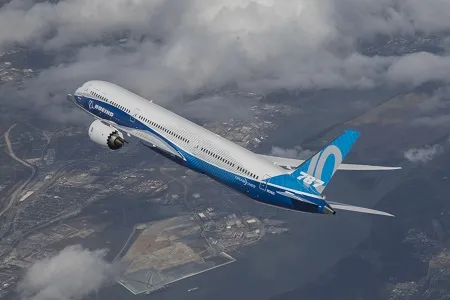
Boeing 787-10 and Airbus A319neo take first flights.
Apr 01, 2017

The Boeing 787-10 and Airbus A319neo marked significant milestones in aviation history with their inaugural flights. The 787-10, an extended variant of the Dreamliner series, took to the skies showcasing its fuel efficiency and passenger comfort, featuring a spacious cabin and advanced technology. Meanwhile, the A319neo, an updated version of the popular A319, demonstrated enhanced performance and reduced emissions, benefiting from new engines and aerodynamic improvements. Both aircraft represent the ongoing evolution of commercial aviation, aiming to meet the growing demand for air travel while prioritizing sustainability and passenger experience. Their successful first flights underscored the manufacturers' commitment to innovation.
The aviation industry continuously evolves, and the first flights of the "Boeing 787-10" and the "Airbus A319neo" mark significant milestones in commercial aviation. These aircraft not only showcase advanced technology and design but also represent a leap forward in fuel efficiency and passenger comfort. In this article, we will explore the features, specifications, and implications of these aircraft for airlines and travelers alike.
Boeing 787-10 Overview
The "Boeing 787-10", the largest variant of the Dreamliner family, is designed to accommodate more passengers while maintaining the fuel efficiency and comfort that the 787 series is known for. With its longer fuselage, the 787-10 can carry up to 330 passengers in a two-class configuration, making it an attractive option for airlines operating medium to long-haul routes.
Key Features of the Boeing 787-10
| Feature | Description |
|---|---|
| Capacity | Up to 330 passengers (two-class) |
| Range | 6,430 nautical miles (11,850 km) |
| Fuel Efficiency | 20% more fuel-efficient than previous models |
| Cockpit Technology | Advanced avionics and fly-by-wire systems |
| Passenger Comfort | Larger windows, quieter cabins, improved air quality |
The "Boeing 787-10" is equipped with the latest technological advancements, ensuring a smooth flying experience. The aircraft’s composite materials contribute to its lighter weight, directly influencing its fuel efficiency. Airlines are increasingly looking towards such options to reduce operational costs and environmental impact.
Airbus A319neo Overview
On the other hand, the "Airbus A319neo" represents a significant upgrade to the popular A320 family. The "neo" stands for "New Engine Option," and this aircraft is designed for short to medium-haul flights, carrying approximately 140 to 160 passengers. With its advanced engines and aerodynamic improvements, the A319neo offers airlines a competitive edge in efficiency.
Key Features of the Airbus A319neo
| Feature | Description |
|---|---|
| Capacity | 140 to 160 passengers |
| Range | 3,750 nautical miles (6,950 km) |
| Fuel Efficiency | 15% improvement over previous models |
| Engine Options | CFM LEAP-1A or Pratt & Whitney PW1100G |
| Cockpit Technology | Modernized cockpit with advanced navigation systems |
The "Airbus A319neo" is a versatile aircraft that can serve various routes efficiently, thanks to its fuel-efficient engines and enhanced performance capabilities. The introduction of new engine technology allows airlines to reduce fuel consumption and CO2 emissions, aligning with the industry's growing focus on sustainability.
Comparative Analysis of Boeing 787-10 and Airbus A319neo
While both the "Boeing 787-10" and "Airbus A319neo" are revolutionary in their right, they cater to different segments of the market. Below is a comparative analysis of their specifications:
| Specification | Boeing 787-10 | Airbus A319neo |
|---|---|---|
| Capacity | 330 passengers | 140 to 160 passengers |
| Range | 6,430 nautical miles | 3,750 nautical miles |
| Fuel Efficiency | 20% better | 15% better |
| Target Market | Medium to long-haul | Short to medium-haul |
These differences highlight the unique advantages of each aircraft, allowing airlines to select the best option based on their operational needs. The "Boeing 787-10" is ideal for long-distance travel with higher passenger capacity, while the "Airbus A319neo" excels in efficiency for shorter routes.
Conclusion
The first flights of the "Boeing 787-10" and "Airbus A319neo" are a testament to the ongoing innovation in the aviation industry. Both aircraft promise to deliver enhanced performance, fuel efficiency, and passenger comfort, shaping the future of air travel. With airlines increasingly focused on sustainability, these models represent a significant step toward a greener future in aviation. As travelers seek more comfortable and eco-friendly options, the advancements in these aircraft will likely play a crucial role in meeting those demands.
Related Articles

Explore Thailand: The Best Islands to Visit for Paradise, Adventure, and Relaxation

The Ultimate Guide to the Best Islands in Thailand for Your Next Getaway

Do babies need passports? How to get a passport for a newborn

How to get a U.S. passport fast: here’s how to expedite the process

What is Mobile Passport Control: 5 reasons why you should use it

SENTRI vs. Global Entry: A detailed guide

Do you need a passport to go to the Bahamas? Let’s find out

Do you need a passport to go to Mexico? A detailed guide

Do you need a passport to go to Canada? We got the answer

Do You Need a Passport for a Cruise: An Essential Travel Guide

Booster Seat Requirements: All the Rules to Follow in Your Rental Car

What Are the World’s Most Powerful Passports, and How Does Yours Rank?

How to Take a Passport Photo at Home: A Helpful Guide

You've got to have heart! Southwest's new livery

Your opinion: Should water be free on low cost carriers?

Young women bolder than guys as solo travellers
